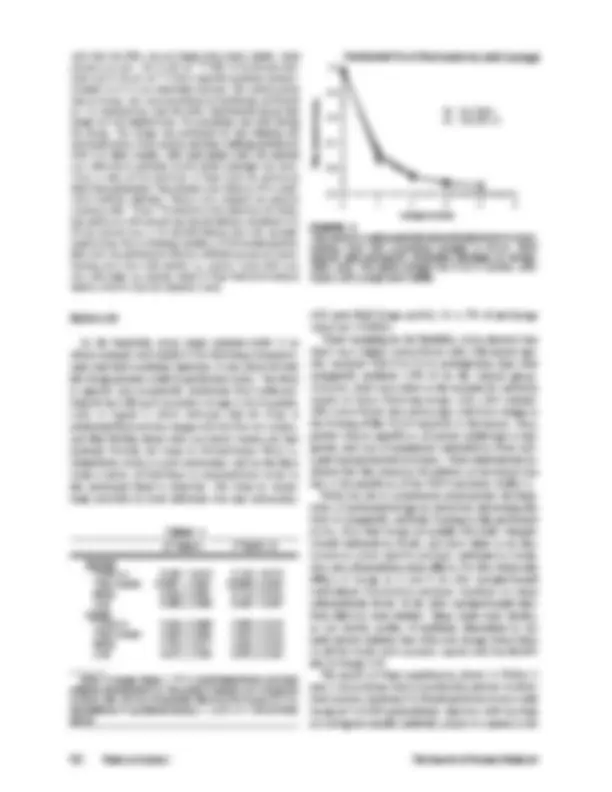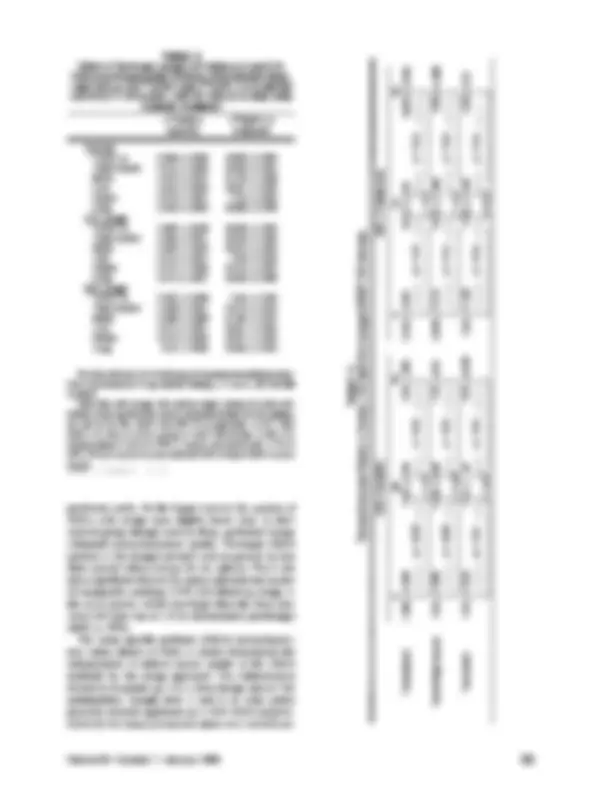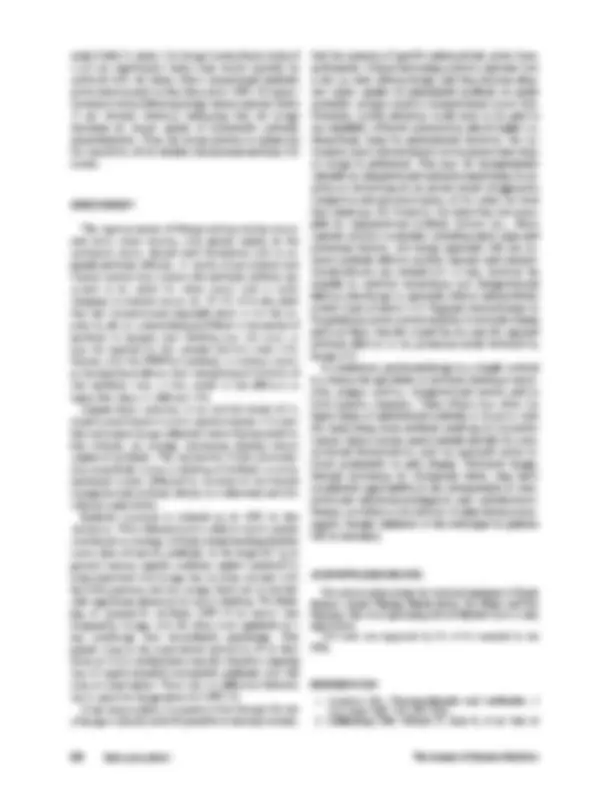





Study with the several resources on Docsity

Earn points by helping other students or get them with a premium plan


Prepare for your exams
Study with the several resources on Docsity

Earn points to download
Earn points by helping other students or get them with a premium plan
Community
Ask the community for help and clear up your study doubts
Discover the best universities in your country according to Docsity users
Free resources
Download our free guides on studying techniques, anxiety management strategies, and thesis advice from Docsity tutors
A study conducted by Richard L. Wahl and Monica Liebert at the University of Michigan, where they investigated the effect of peritoneal lavage on the uptake of radiolabeled monoclonal antibodies in a nude mouse model of human intraperitoneal ovarian carcinomatosis. The study found that lavage significantly improves intraperitoneal tumor/nontumor uptake ratios of specific antibody, allowing for more targeted delivery and less systemic exposure.
What you will learn
Typology: Exercises
1 / 6

This page cannot be seen from the preview
Don't miss anything!




Improved Radiolabeled Monoclonal Antibody
Uptake by Lavage of Intraperitoneal
Carcinomatosis in Mice
Division ofNuclear Medicine, Department oflnternal Medicine, University of Michigan
administeredtumor-specific(131l-5G6.4)and nonspecific(125I-UPC-10)radiolabeledmonoclonal
carcinomatosis(lP3 model).Pentoneallavageat 2 or 6 hr postintrapentonealantibody injection significantly improves intraperitoneal tumor/nontumor uptake ratios of specific antibody apparently by limiting systemic exposure to antibody. This enhancement tends to be more dramatic if lavage is performed within 2 hr, rather than 6 hr, of intrapentoneal antibody administration,thoughbothtimesresultinsignificantimprovementsintarget/background ratios over no lavage. Twenty-four-hour tumor/nontumor ratios for specific antibody 5G6.
nonspecific antibody UPC-10 binding is lower in tumor and normal tissues following Iavage, with no Iavage-inducedimprovementin tumor/nontumorratiosseen. Pentoneallavageis a
to limitsystemicexposurethus increasingthe therapeuticmargin.This methodmay have
intrape,itoneal tumors.
J Nucl Med 30: 60-65, 1989
target/background ratios and absolute tumor delivery
localized diseases, such as those limited to the lymphat ics or body cavities, the possibility of regional antibody
malignancies that commonly are limited to the perito
Intraperitoneal delivery of monoclonal antibodies
cavity to radioantibody than does intravenous admin
Received May 13, 1988; revision accepted Aug. 31, 1988. For reprints contact: Richard L. Wahl, MD, University of Michigan, Medical Center, 1500 East Medical Center Dr., Ann Arbor, MI 48109-0028.
ascites cells postintraperitoneal injection, and high solid tumor/blood ratios soon after intraperitoneal injection (10, 11). This can also translateto higherabsolute tumor uptake and less systemic exposure at early times
dioantibody eventually rise due to absorption. With
60 WahIandLiebert The Journalof NuclearMedicine
bility of this approach in a nontumor bearing animal system through the use of systemically-administered
sized that a similar reduction (or lack of rise in) blood
is lavaged with saline postintraperitoneal injection.
antibody would be firmly attached to intraperitoneal
improving tumor/background ratios. Lavage of radio
whether peritoneal lavage would limit the systemic
neally in a system with intraperitoneal tumor present (HTB77 IP3 ovarian cancer model) (14). The concept
METhODS Antibodies 506.4 is a murine IgO2a kappa and binds to most ovarian cancers (18). It localizes specifically when labeled to ovarian
myeloma protein without known specificity (Bionetics, Inc.,
@@ c
@ ‘@ p @‘ @@ .$@;‘@‘@ @.
@@.
@@@. ::‘@z@L@:,,: - @ ;*.,@,•
@@@ .J. @,*-@
@@ -&...-@-
labeled using the lodogen method(Pierce Chemical Company,
with 60—80%efficacy ofincorporation (20). Separation of free from bound iodine is through the use of anion exchange chromatography. Immunoreactivities are measured by a 1-hr
cells (ATCC) (21).
Animal Model The HTB-77 1P3 model is a model we have developed of human intraperitoneal ovarian carcinomatosis that grows well intraperitoneally in the nude mouse and mimics human ovar ian carcinoma (22). Athymic Swiss Nu/Nu mice first receive
kee, WI). One week later, they are innoculated i.p. with 10 million HTB77 IP3 ovarian carcinoma cells. Small tumors grow and attach to bowel, peritoneum, and invade the dia phragm (Fig. 1). The mean tumor size in this study was #@ 0.4 g.
The study was divided into two parts, an initial feasibility study, with kill time immediately after lavage to determine the completeness of lavage, and a later study allowing the animals to survive nearly 24 hr postlavage. In the first part of the study, two groups of four nude mice, each with HTB-
dual-label mixture composed of 9 @Ciof iodine-l31 (‘@‘I) 5G6.4 and 13 g@Ciof iodine-125 (‘25I)UPC-lO. The experi mental animals were lavaged four times with 2 cc of saline/ wash beginningat 1.75 hr following intraperitoneal antibody injection. The animals were injected i.p. with saline and then the peritoneal cavity, after allowing for brief mixing, was drained in the prone position while the mouse was suspended by the neck and tail. Dose calibrator readings on the whole animal were performed before and after each lavage. The multiple lavages were completed by 2.4 hr following antibody injection. The control and experimental mice were then killed with tissues and fluids weighed and counted.
nude mice were studied to determine ifsystemic exposure was lessened by lavage, whether early or later lavage was superior,
focus of HTB77 lP3 ovarian cancer attheperitonealsurface.
.-‘. .,.-.
@ -,. ‘—a- ,@:
Volume30 •Numberi •Januaryi 989 (^61)
2Effect TABLE hrFollowing of Pentoneal Lavage with Saline at 2 and 6 Intraperitoneal AntibOd@@Administration (Dual Label Mixture of [131I]5G6.4animalswith and [ @IJUPC-10)to HTB-77 lP3 tumors, with Kill Time 24 hr AfterInitialAntibody
[125l](Jp@10(Specific)
04@ II@ V (a 0.@ 0.
ol dl ZI V I V I ‘II 0.1 0.1 0.
C,) ice ice' 0 10 10 @ 0 +1 @H—J. @@@ 0)Co ,@.
@ u@
@ .@ •
@2 J @
Results:(killtime24 hr followingintraperitonealantibodyinjec tion):expressedas % kg injecteddose/g±i s.e.m.(32animals studied). NotethatwithIavage,thenormalorganuptakeforbothanti bodiesdropssignificantlyversuscontrols(exceptfor the spleen), as wellas forthetumorwithUPC-10(p generally<0.01). With 5G6.4,nodropintumoruptakeis seenwithlavage.In the 1-hr bindingassayin vitroto HTB-77ovariancarcinomacells,<1% of UPC-i0 inputcountsbound,while30—50%ofinput5G6.4counts bound.
ControlsTumor 0.004Thigh i.p.0.063 ±0.0050.063 ± 0.0040.036±0.007Blood0.072 muscle0.016 ± 0.009Liver0.021 ±0.0070.148 ± 0.001Spleen0.016 ±0.0020.031 ± 0.0010.03±0.002Lung0.040 ± 0.0062-hr ±0.0040.083 ± LavageTumor 0.002Thigh i.p.0.061 ±0.0160.034 ± 0.0010.014±0.001Blood0.024 muscle0.005 ± 0.006Uver0.013 ±0.0030.075 ± 0.002Spleen0.015 ±0.OOi0.02 ± 0.001Lung0.014 ±0.0020.018 ± 0.0026-hr ±0.OOi0.034 ± LavageTumor 0.006Thigh i.p.0.056 ±0.0060.05 ± 0.001Blood0.048 muscle0.009 ±0.0010.016 ± 0.0060.190±0.007Liver0.012 ± ±0.001Spleen0.015 ±0.0010. 0.001Lung0.02 ±0.0020.021 ± ±0.0020.045 ±0.
(I) E
C@) 0@ N.N. I-
v@ 04 In peritoneal cavity. In the largest tumors the uptakes of
postinjection, though both 2 and 6 hr time points
ments in the tumor/nontumor ratios over control ani
Volume30 •Number1 •Januaryi 989 63
,- ‘ c@JIn I- 0 CV) 01* 0 0 0
@@ 01 @+I @+I (^) ll@@+I II @ t@;-i a@-i C @@@ 0 C')
C1J U) ZI z H I
1@ @Ifl @ (^) 0 i;. 10 @ 0 +1—a (^10) I0 0) 0 01
U) z
01 0 @11— 01
F,. 0 0 @H .11—
N.
U) In z z II II
01
Co @11—I.
01
0
mals (Table 3). mean 2-hr lavage tumor/blood ratios of 6.3/1 are significantly better than would typically be achieved with the intact 506.4 monoclonal antibody given intravenously at this time point. UPC-10 tumor/ nontumor ratios following lavage versus controls (Table
The regional nature ofdisease such as ovarian cancer and some colon cancers, with spread mainly in the
gional antibody delivery. A variety of pre-clinical and clinical studies have shown this antibody delivery ap proach to be useful for colon cancer and in some
that the intraperitoneal approach alone is not the an
antibody to antigen, then binding may not occur or may be superior by the vascular delivery route (12).
that antibody may, in fact, result in less delivery to tumor foci than i.v. delivery (14). Despite these concerns, in our animal model of in
that peritoneal lavage enhances tumor/background ra
non most likely is due to binding of antibody to intra peritoneal tumor, followed by removal of non-bound
Systemic exposure is reduced up to 50% by this maneuver. This enhancement in relative tumor uptake isachieved,on average,without compromisingabsolute tumor dose of specific antibody. In the larger (0.7 g or
drop somewhat with lavage, but no drop was seen with the 0.06 g tumors and on average there was no statisti cally significant alteration in tumor binding. The bind ing of nonspecific antibody UPC-lO to tumor was
day postlavage than immediately postlavage. This greater drop in the experiments carried to 24 hr than
time of observation. There was no difference between the 2- and 6-hr lavage times for UPC-lO.
fold the amount of specific radioantibody given intra
lute tumor uptake of radiolabeled antibody to small, accessible, antigen positive intraperitoneal tumor foci. Naturally, careful attention would need to be paid to the possibility of bowel radiotoxicity should higher ra
mulative dose to bowel should not be greater than when no lavage is performed. This may be therapeutically
intraperitoneal adenocarcinoma of the colon we have been studying (24). Certainly, for tumor foci not acces sible by intraperitoneal antibody delivery (i.e., where
subserosal lesions), this lavage approach will not en hance antibody delivery as both vascular and intraper
possible to combine intravenous and intraperitoneal delivery plus lavage to optimally deliver radioantibody
antibody delivery to the pentoneal cavity followed by lavage (25).
sible, antigen positive, intraperitoneal tumors and to limit systemic exposure. These effects may allow for higher doses of radiolabeled antibody to be given with
peritoneal dissemination, such an approach seems ra
considerable applicability in the enhancement of intra peritoneal radioimmunodiagnosis and radioimmuno therapy, as well as in the delivery ofother immunocon
The authors acknowledge the technical assistance of Gayle Jackson, Joseph Wissing, Martin Strnat, Sue Fisher and Phil Sherman. The word processing skill of Michele Curro is also appreciated.
64 WahIandLiebert The Journalof NuclearMedicine